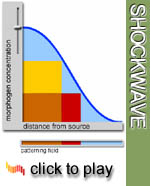The development of multicellular
organisms requires a tight coordination of developmental decisions. One
of the most fundamental strategies of orchestrating such decisions is
the use of morphogen gradients. Morphogens provide a means by which cells
are given information about their position within a patterning field.
 A
morphogen is a diffusible signal produced in one part of the body, which
can determine cell fates according to its local concentration. The concentration
of the morphogen changes over distance, the highest concentration being
at its source. In order to translate this gradient into a spatial pattern,
cells need to be able to sense different concentrations of the morphogen.
Cells that sense a high concentration of the morphogen, and are thus close
to the morphogen source elicit a response different to those further away
from the source, where the morphogen concentration is low.
A
morphogen is a diffusible signal produced in one part of the body, which
can determine cell fates according to its local concentration. The concentration
of the morphogen changes over distance, the highest concentration being
at its source. In order to translate this gradient into a spatial pattern,
cells need to be able to sense different concentrations of the morphogen.
Cells that sense a high concentration of the morphogen, and are thus close
to the morphogen source elicit a response different to those further away
from the source, where the morphogen concentration is low.
Examples of morphogens in the development of Drosophila are manifold. The early patterning of the Drosophila egg as well as those of the adult structures is based on the principle of morphogen gradients in several respects.

Media list
 Morphogen
Morphogen
 A
morphogen is a diffusible signal produced in one part of the body, which
can determine cell fates according to its local concentration. The concentration
of the morphogen changes over distance, the highest concentration being
at its source. In order to translate this gradient into a spatial pattern,
cells need to be able to sense different concentrations of the morphogen.
Cells that sense a high concentration of the morphogen, and are thus close
to the morphogen source elicit a response different to those further away
from the source, where the morphogen concentration is low.
A
morphogen is a diffusible signal produced in one part of the body, which
can determine cell fates according to its local concentration. The concentration
of the morphogen changes over distance, the highest concentration being
at its source. In order to translate this gradient into a spatial pattern,
cells need to be able to sense different concentrations of the morphogen.
Cells that sense a high concentration of the morphogen, and are thus close
to the morphogen source elicit a response different to those further away
from the source, where the morphogen concentration is low.Examples of morphogens in the development of Drosophila are manifold. The early patterning of the Drosophila egg as well as those of the adult structures is based on the principle of morphogen gradients in several respects.
Media list